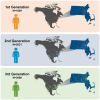Risk for hypertension crosses generations in the community: a multi-generational cohort study
- PMID: 28430902
- PMCID: PMC6075041
- DOI: 10.1093/eurheartj/ehx134
Risk for hypertension crosses generations in the community: a multi-generational cohort study
Abstract
Aims: Parental hypertension is known to predict high blood pressure (BP) in children. However, the extent to which risk for hypertension is conferred across multiple generations, notwithstanding the impact of environmental factors, is unclear. Our objective was therefore to evaluate the degree to which risk for hypertension extends across multiple generations of individuals in the community.
Methods and results: We studied three generations of Framingham Heart Study participants with standardized blood pressure measurements performed at serial examinations spanning 5 decades (1948 through 2005): First Generation (n = 1809), Second Generation (n = 2631), and Third Generation (n = 3608, mean age 39 years, 53% women). To capture a more precise estimate of conferrable risk, we defined early-onset hypertension (age <55 years) as the primary exposure. In multinomial logistic regression models adjusting for standard risk factors as well as physical activity and daily intake of dietary sodium, risk for hypertension in the Third Generation was conferred simultaneously by presence of early-onset hypertension in parents [OR 2.10 (95% CI, 1.66-2.67), P < 0.001] as well as in grandparents [OR 1.33 (95% CI, 1.12-1.58), P < 0.01].
Conclusion: Early-onset hypertension in grandparents raises the risk for hypertension in grandchildren, even after adjusting for early-onset hypertension in parents and lifestyle factors. These results suggest that a substantial familial predisposition for hypertension exists, and this predisposition is not identical when assessed from one generation to the next. Additional studies are needed to elucidate the mechanisms underlying transgenerational risk for hypertension and its clinical implications.
Keywords: Blood pressure; Environment; Genetics; Heritability; Hypertension.
Published on behalf of the European Society of Cardiology. All rights reserved. © The Author 2017. For permissions, please email: journals.permissions@oup.com.
Figures




Comment in
-
Understanding the role of genetics in hypertension.Eur Heart J. 2017 Aug 1;38(29):2309-2312. doi: 10.1093/eurheartj/ehx273. Eur Heart J. 2017. PMID: 28541494 No abstract available.
References
-
- Ference BA, Ference TB, Brook RD, Catapano AL, Ruff CT, Neff DR, Smith GD, Ray KK, Sabatine MS. A naturally randomized trial comparing the effect of long-term exposure to lower LDL-C, lower SBP, or both on the risk of cardiovascular disease. Abstract presented at European Society of Cardiology Meeting 2016, August 29, 2016, Milan, Italy.
-
- Mancia G, Fagard R, Narkiewicz K, Redon J, Zanchetti A, Bohm M, Christiaens T, Cifkova R, De Backer G, Dominiczak A, Galderisi M, Grobbee DE, Jaarsma T, Kirchhof P, Kjeldsen SE, Laurent S, Manolis AJ, Nilsson PM, Ruilope LM, Schmieder RE, Sirnes PA, Sleight P, Viigimaa M, Waeber B, Zannad F, Redon J, Dominiczak A, Narkiewicz K, Nilsson PM, Burnier M, Viigimaa M, Ambrosioni E, Caufield M, Coca A, Olsen MH, Schmieder RE, Tsioufis C, van de Borne P, Zamorano JL, Achenbach S, Baumgartner H, Bax JJ, Bueno H, Dean V, Deaton C, Erol C, Fagard R, Ferrari R, Hasdai D, Hoes AW, Kirchhof P, Knuuti J, Kolh P, Lancellotti P, Linhart A, Nihoyannopoulos P, Piepoli MF, Ponikowski P, Sirnes PA, Tamargo JL, Tendera M, Torbicki A, Wijns W, Windecker S, Clement DL, Coca A, Gillebert TC, Tendera M, Rosei EA, Ambrosioni E, Anker SD, Bauersachs J, Hitij JB, Caulfield M, De Buyzere M, De Geest S, Derumeaux GA, Erdine S, Farsang C, Funck-Brentano C, Gerc V, Germano G, Gielen S, Haller H, Hoes AW, Jordan J, Kahan T, Komajda M, Lovic D, Mahrholdt H, Olsen MH, Ostergren J, Parati G, Perk J, Polonia J, Popescu BA, Reiner Z, Ryden L, Sirenko Y, Stanton A, Struijker-Boudier H, Tsioufis C, van de Borne P, Vlachopoulos C, Volpe M, Wood DA.. 2013 ESH/ESC guidelines for the management of arterial hypertension: the Task Force for the Management of Arterial Hypertension of the European Society of Hypertension (ESH) and of the European Society of Cardiology (ESC). Eur Heart J 2013;34:2159–2219. - PubMed
-
- Ference BA, Julius S, Mahajan N, Levy PD, Williams KA S, Flack JM.. Clinical effect of naturally random allocation to lower systolic blood pressure beginning before the development of hypertension. Hypertension 2014;63:1182–1188. - PubMed
-
- Oliver WJ, Cohen EL, Neel JV.. Blood pressure, sodium intake, and sodium related hormones in the Yanomamo Indians, a “no-salt” culture. Circulation 1975;52:146–151. - PubMed
-
- Page LB, Damon A, Moellering RC Jr.. Antecedents of cardiovascular disease in six Solomon Islands societies. Circulation 1974;49:1132–1146. - PubMed
MeSH terms
Grants and funding
LinkOut - more resources
Full Text Sources
Other Literature Sources
Medical

